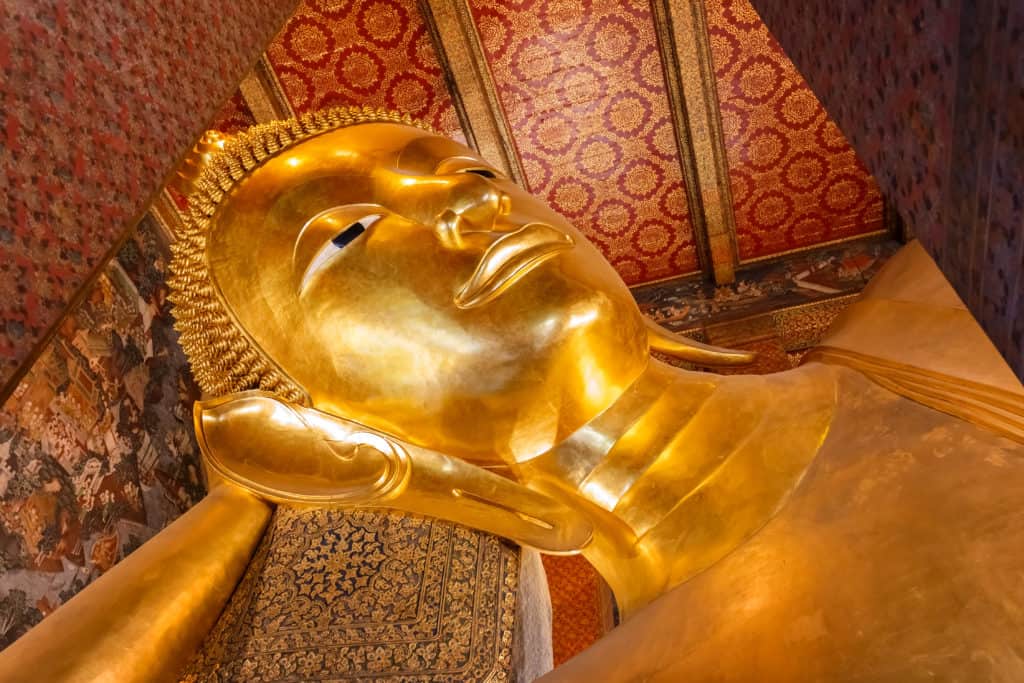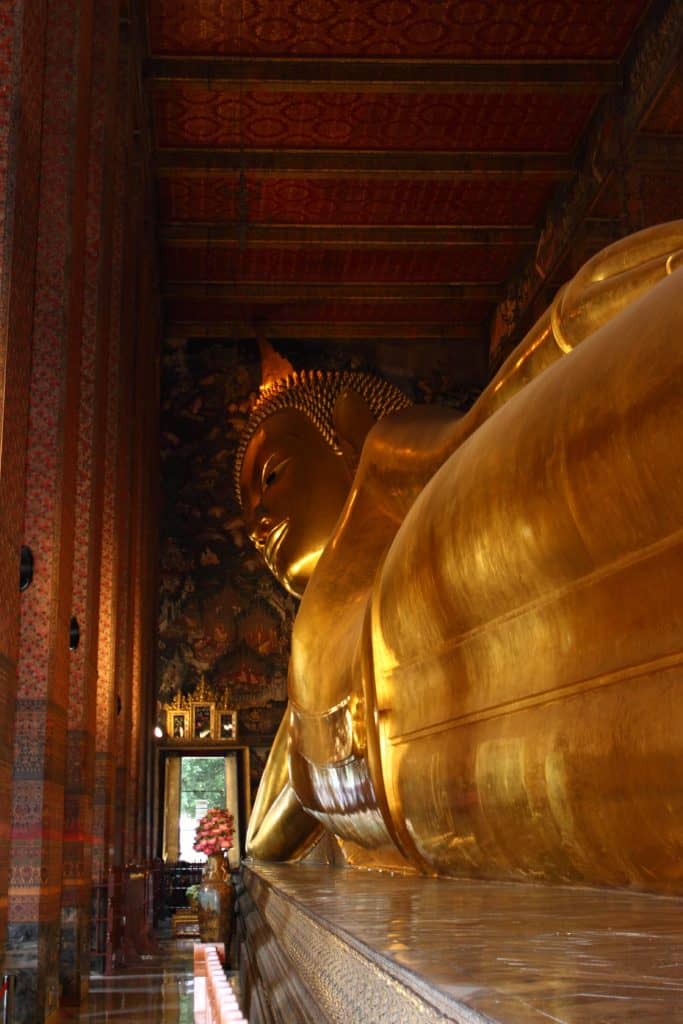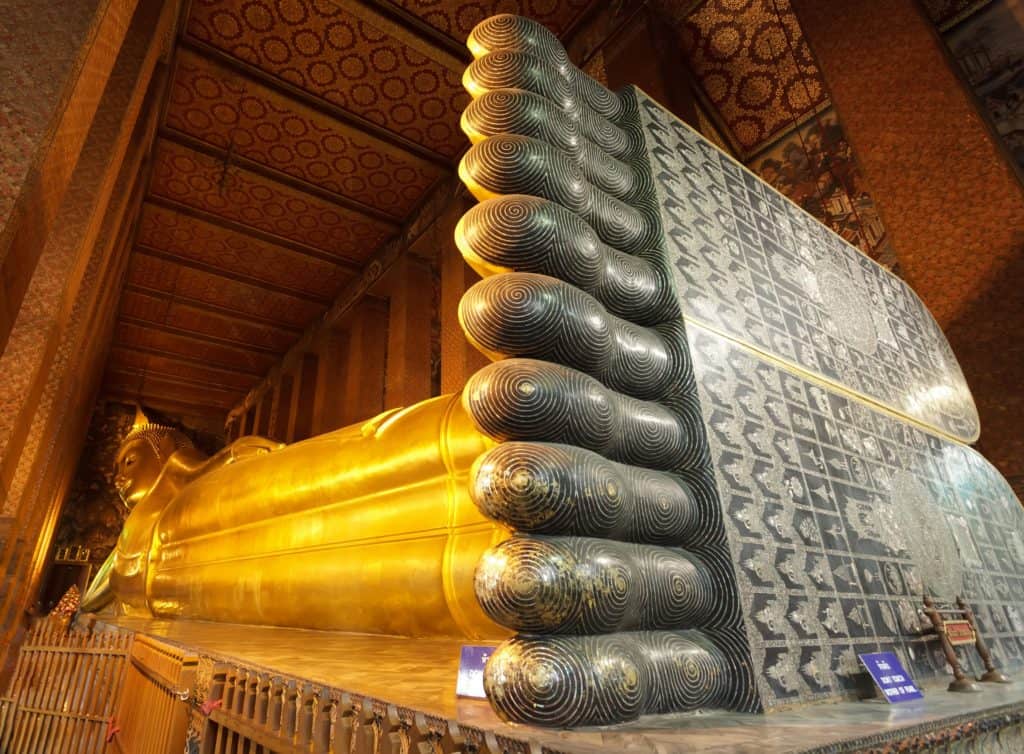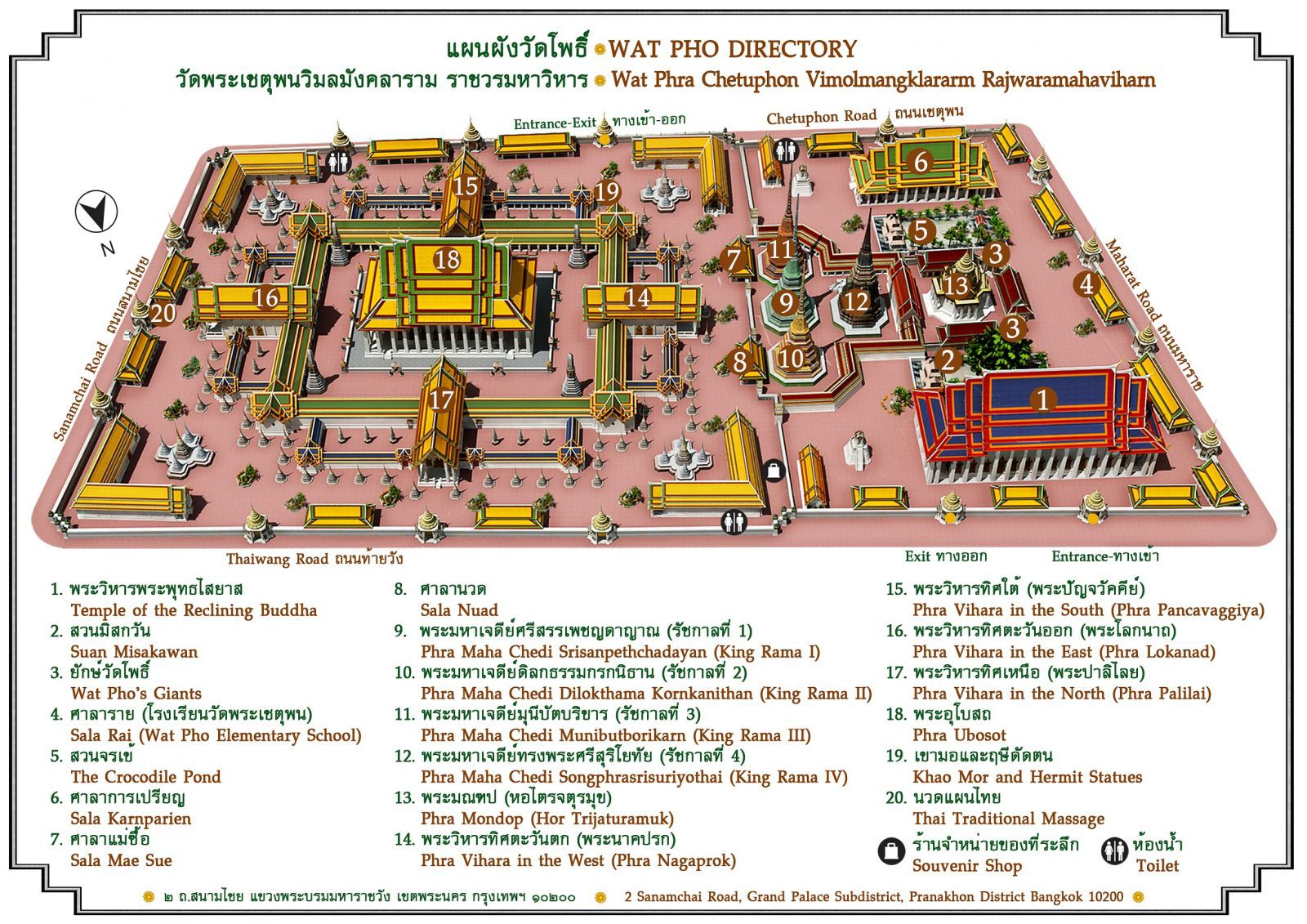
In Thai, the word for a Buddhist temple is “Wat” (pronounced the same as the English word “watt”). There are an overwhelming number of these religious centers not only in Bangkok, but in Thailand at large. They are all beautiful in their own ways, with their own unique designs and statues. On your visit, you would certainly get an interesting perspective on the daily lifestyle of the Thais by visiting some of the smaller temples. However, it is recommended that you focus on the most impressive sites. Some have Buddha statues that are very large and masterful works of art.
So, what is the biggest Buddha statue to check out in Bangkok? That would be the Reclining Buddha at Wat Pho (also known as Wat Phra Chetuphon). Aside from being pretty tall, and very long, this Buddha statue and its associated Wat are very special to the history and culture of Thailand.
Location
Wat Pho (pronounced “Poe” as in Edgar Allan Poe), is conveniently located just behind Tha Tian Market. This is directly across the Chao Phraya River from Wat Arun, the iconic temple which is probably the most identifiable landmark in all of Bangkok, and there is a ferry that can zip you across the water between the two if you would like to hit them both in one day. The exact address of Wat Pho is:
2 Sanam Chai Rd, Khwaeng Phra Borom Maha Ratchawang, Khet Phra Nakhon, Krung Thep Maha Nakhon 10200, Thailand
Wat Pho

The original temple on the site of modern-day Wat Pho is believed to have been constructed in the late 17th Century, a good 65 to 80 years before the capital of Siam was moved to what is now Bangkok.
When King Rama I moved the capital in 1767, a decision forced by the Burmese sacking of the previous capital Ayutthaya, he established his palace right alongside Wat Arun. With Wat Pho being directly across the river from the new palace, tremendous significance was conferred to the temple, persisting to this day. In fact, Wat Pho is regarded as one of the 6 most important royal temples in the entire nation of Thailand. This is in part due to the fact that some of the ashes of Rama I are located on the premises. These ashes are kept beneath another Buddha statue in the Phra Ubosot, which is the primary venue for Buddhist ceremonies held at the complex. Incidentally, this is another impressive, beautiful and towering Buddha statue – the Phra Buddha Deva Patimakorn – and is definitely worth visiting as well.
Additionally, Wat Pho holds the distinction of housing the largest collection of Buddha images in Thailand. It is also a very large complex, at about 22 acres. There is a great deal to see at this revered destination.
Also worthy of note regarding Wat Pho is that it was the original cornerstone of public education in Thailand, and has been recognized as such for hundreds of years. All around the temple, engraved in stone, are pictographic lessons on numerous academic subjects, including history, medicine and literature. Of particular import to visitors to Bangkok is that Wat Pho is where Thai massage was first developed. This is worthy of thanks and praises the world over. Even now, the compound is home to a free public Thai massage school, with a comprehensive course of study that ends with a certificate. And yes, you can get a massage here. No matter your religious denomination, we can all agree that Wat Pho is doing God’s work.
The Reclining Buddha
Though the original Wat Pho goes back to the 17th Century, the Reclining Buddha and the temple which houses it date to 1832, when King Rama III commissioned their construction. Rama III is responsible for the vast expansion and renovation of Wat Pho at that time.

Appropriately, the Reclining Buddha at Wat Pho is locally known as “Big Buddha”. Technically, the name of the statue is Phra Buddhasaiyas. But if you are taking a taxi or tuk-tuk to the temple, your driver should know where you want to go if you tell him “Big Buddha”.
As you may gather from the photos, while the statue is fairly tall, its length is even more substantial. The statue is about 50 feet tall and 150 feet long. The construction of the statue is a brick core which was then covered in plaster and expertly sculpted before being coated in gold leaf.
The Reclining Buddha was built and then, according to the royal poet and monk, Prince Paramanuchitchinorot, the brick and stucco building was erected around it. It is known as the Phra Vihara. The building is wide but shallow, which is why it is difficult to get a frontward photo that truly captures the size and grandeur of the statue. You really have to stand before it to appreciate it properly.
All throughout the space, on nearly every surface, you will find murals which tell various stories, some historical, others legends. Some murals serve as historical documentation of such topics as ancient Thai weaponry and the zodiac. Curiously, there is one stone tablet which is very beautifully framed yet is otherwise completely blank. The theory on this one is that it had been reserved, intended to tell the story about the construction of the statue and the building. Unfortunately, the story was never written.

The feet of the Reclining Buddha are nearly 10 feet tall and over 16 feet wide, and are inlaid with mother-of-pearl designs that represent the chakras – depicted by the circles at the center of his soles – and various aspects of Buddha – depicted by the 108 images surrounding the chakras. The number 108 is an auspicious number in Buddhism for a variety of reasons.

The image of Buddha in repose is a common theme throughout the Buddhist world. This posture is meant to represent Buddha transitioning into Nirvana, which is the release of the self from the process of rebirth. In the Judeo-Christian traditions, we would think of this as death, but the Buddhists see it more as attainment of the ultimate goal of the soul, when a return to the earthly world is no longer necessary.
At Songkran (Thai New Year, April 13-15), there is a major festival at Wat Pho, the “Worship of the Reclining Buddha”. This festival actually runs longer than Songkran typically does, starting April 12 and ending April 16.
As is the case with any Buddhist temple, you are to remove your shoes before entering. A common practice at the Reclining Buddha is to purchase 108 coins for 20 baht (less than a dollar), which you then deposit into a bowl for good luck.
Hours & Visitor Information
Wat Pho is open daily from 8am to 6:30pm. Foreigners must pay an entrance fee of 200 baht (about $6). Modest dress is required of all visitors at all temples in Thailand, and ladies must not wear shorts or skirts cut above the knees. Respectful behavior is an absolute non-negotiable requirement at all times. In Thai culture, nothing is more highly-respected than Buddha, and a close second would be the royal family.
The School of Traditional Medicine and Traditional Massage at Wat Pho is open from 8am to 5pm daily. Some advice… don’t just roll up and expect a spot. It could work, but you’re better off dropping by the massage school as soon as you arrive and booking a spot to ensure you get your rub on! Rates for services are as follows:
- Thai massage: 260 baht per hour (that’s $7 to $8!)
- Foot massage: 280 baht for 30 minutes ($8 to $9) or 400 baht per hour ($12 to $13)
For your convenience, we have linked to the visitor map of Wat Pho from their official website. Click the image to open the full size in a new window:

You will find the Temple of the Reclining Buddha (Phra Vihara) at #1 on the map. The massage school is located at #20. The ashes of Rama I are under the Buddha statue at Phra Ubosot, #18. Also note the locations of the restrooms, and don’t forget the souvenir shop!
